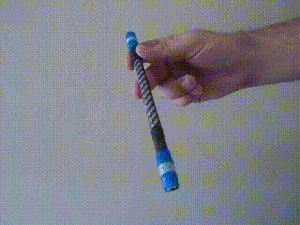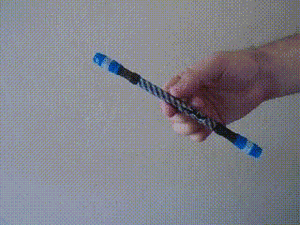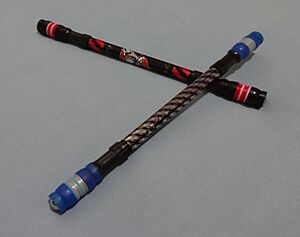Pen spinning facts for kids
Pen spinning is a cool hobby where you use your hands to skillfully spin a pen or pencil around! People often do it to entertain themselves, like in school or at the office. But it's also a serious activity with big competitions and meetings held around the world.
Some people think of pen spinning as a type of contact juggling, but sometimes the pen actually leaves your hand for a moment. Drummers also often spin their drumsticks, which are easier to spin than pens because they are heavier and longer. Pen spinning has become super popular worldwide, especially through online videos and communities, and it's been around since at least the 1970s.
Contents
Pen Spinning Community
The pen spinning community mostly connects online. They use websites, video sharing platforms, and chat apps like Discord. Many communities are based in specific countries, like Japan, France, Germany, and China. There are also international groups, like the Universal Pen Spinning Board and communities on Reddit. Sometimes, older online groups become quiet as people move to newer ones. Even though these groups are separate, they sometimes work together for big international events.
Competitions
Pen spinning tournaments happen online, and sometimes live events are held in places like China, Japan, and Korea. The biggest events are the World Tournament and the World Cup. These usually happen every other year since 2007.
Both tournaments use a knockout style, meaning if you lose, you're out! The World Tournament is for individual spinners. The World Cup is for teams, where multiple spinners represent their online community. Anyone from a community can ask to join. The best spinners usually get a spot, often by sending in videos or by winning past events.
Judging in these competitions isn't always the same, and sometimes judges might have favorites. Since pen spinning is very creative, scores and comments for the same video can be quite different!
Besides the big tournaments, there are also smaller "battles." In these, at least two spinners send in videos of their spinning. The community then votes to decide who performed better.
How Spinners Talk About Tricks
Spinners use special ways to describe how they spin the pen. This includes names for fingers, symbols, and abbreviations.
Finger Slots
To make things easy, pen spinners have a common way to name their fingers and the spaces between them. These are called "finger slots."
- Your index finger is "1."
- Your middle finger is "2."
- Your ring finger is "3."
- Your little finger is "4."
- Your thumb is "T."
Finger slots are named by putting two or more of these together. For example:
- The space between your index and middle fingers is "12."
- If you hold a pen between your thumb and ring finger, it's in slot "T3."
Spinners can also use symbols for other parts of the hand or body. "TF" means the webbing between your thumb and index finger. "P" means your palm. Sometimes, an "*" is used to show that nothing else is holding the pen. For example, "P*" means the pen is just resting on your palm.
Notations
A notation system is a way to write down how a pen was spun. It often combines trick names, directions, and finger slots. Some systems are very detailed, while others are simple. When tricks get more complex, like spinning one pen with two hands ("1p2h"), more detailed systems are needed.
Here's a common system that's simple and effective:
- Modifier: This adds something extra to the trick. For example, "Fingerless" (shortened to "FL") means the whole hand or wrist starts the trick, not just one finger.
- Trick name: This is the basic name of the trick. It can be shortened, like "ThumbAround" to "TA."
- Direction: This tells you which way the pen spins. If it's not mentioned, it's usually "Normal." If it's "Reverse," it can be shortened to "Rev."
- Number of revolutions: This is how many times the pen spins around, written as a decimal (like 1.0). If it's not mentioned, it's the usual amount for that trick.
- Starting position: This is the finger slot where the trick begins.
- Ending position: This is the finger slot where the trick ends. A "-" is placed between the starting and ending positions.
For example, if you do a ThumbAround without using your fingers, in the normal direction, starting and ending in the thumb flap slot, you could write it as: "Fingerless ThumbAround Normal 1.0 TF-TF." Or, shorter: "FL TA TF-TF."
Breakdowns
Breakdowns are like notes for "hybrids" (a mix of interrupted tricks) and "combos" (combinations of tricks). They explain how a hybrid or combo is done. The simplest breakdowns just use a ">" between tricks to show they are connected.
For example, if you do a Pass from slot 12 to 23, then another Pass from 23 to 34, you'd write: "Pass Normal 12-23 > Pass Normal 23-34." More detailed breakdowns use other symbols to show how tricks are connected or interrupted. There isn't one strict way to write breakdowns; spinners often change the format a bit.
Basic Tricks
In pen spinning, there are four main basic tricks that beginners often learn first. These tricks help you build important skills and understand key ideas in pen spinning.
ThumbAround Normal
To do a ThumbAround, you push the pen with any finger (usually your middle finger) except your thumb. This makes the pen spin once around your thumb. Then, you catch it between your thumb and another finger. Before pen spinning became organized, this trick had many different names, like "360 Degree Normal" or "Thumb Spin."
Sonic Normal
The main goal of a Sonic is to move the pen quickly from one finger slot to another. In the Sonic Normal, you hold the pen in a slot that doesn't use your thumb. You then spin it in a cone-like motion behind a finger (or fingers) to another slot further up your hand. The pen makes one full spin. Hideaki Kondoh is usually given credit for naming this trick "Sonic" because the pen moves so much faster than in a ThumbAround.
Charge Normal
A Charge trick doesn't involve spinning the pen over any fingers or body parts. Instead, the pen spins in a cone shape within a single finger slot. If you look at your palm while doing a Charge Normal, the pen spins clockwise in your right hand and counterclockwise in your left hand. The Charge is the basis for all tricks that use this cone-like movement, including the Sonic. Drummers often do this trick with drumsticks instead of pens.
FingerPass Normal
A single Pass means rotating a pen half a turn (0.5 times) from one finger slot to another. When you do a Pass Normal on the palm side of your hand, the pen moves downward. On the other side of your hand, it moves upward.
A "FingerPass" is a short combination of Passes where the pen spins all the way around your hand, starting and ending in the 12 slot. The FingerPass Normal is made up of Pass Normals. This short combo is often considered the hardest basic trick to master. This is because passing the pen smoothly between your little finger and ring finger can be tricky. In the James Bond movie GoldenEye, the character Boris Grishenko did a Pass combo similar to a FingerPass, but he only used three fingers instead of four.
Advanced Tricks
Beyond the four basic tricks, many more tricks have been invented and are used in combos. Most tricks that aren't the fundamentals are called "advanced tricks." This name can be a bit misleading, as many of these tricks are actually quite simple!
Most advanced tricks are "hybrids." A hybrid is a pen movement that combines at least two tricks, but one or more of those tricks are "interrupted" (not fully finished) before the next trick starts. A complex hybrid can even have another hybrid inside it. Over time, unique names for every new hybrid have become less common. Instead, spinners now use "breakdowns" to explain which interrupted tricks are performed.
Here are some common groups of tricks. The first three are often seen as not too difficult.
Spins
A Spin is when a pen spins in a circle while staying in contact with your hand or another body part. Spins done on the back of your fingers are called "Top Spins." There are many types of Spins, and their names usually tell you which body part the pen spins on. For example, in a Thumb Spin, the pen spins on top of your thumb. Spins are often part of a bigger trick, like a Shadow, which includes Charges and a Top Spin.
"Wipers" are a group of Spin tricks that are often put in a separate category because of how the pen is held. In the Wiper Normal, the pen is held by one end, pointing downward. It then rotates 180 degrees upward in an arc shape. Wipers are considered simple tricks because they are just this one movement. Because the pen is held in an unusual way, Wipers are often used to make combos look more varied. Combos where the pen is always held by one end are sometimes called "Wiper combos." Wipers, along with Passes, form the "Infinity" trick category. These tricks involve pen movements that look like a figure-eight or an infinity symbol.
Arounds
An Around is a trick where the pen spins around one or more body parts. The trick is named after the body part(s) it spins around. For example, in a Middle Index Around, the pen spins around your middle and index fingers. The ThumbAround, which is a basic trick, is usually the first Around a pen spinner learns.
When an Around Reverse is done without using fingers, and you turn your hand or wrist, it's called a BackAround, or simply "Bak." Even though Baks are technically a type of Around, they are often talked about as their own family of tricks. A type of Bak Reverse that uses an upward push from the finger next to where the pen spins is called a Bust. Baks were invented by David Weis, an American spinner. He wanted to create combos where the pen moved smoothly without needing clear finger pushes. Baks are now a very popular trick.
Sonic Variations
Sonic variations are different ways to move the pen from one slot to another, which is the main goal of the basic Sonic trick. The Sonic family is unique because tricks in this group simply have "Sonic" in their names, even if they don't share many features with the original Sonic trick. For example, the Twisted Sonic involves a Charge movement followed by a Pass. This is different from the original Sonic, which is just a Charge combined with the pen switching between finger slots (called a Fingerswitch). Tricks in this group mostly use cone-like movements.
Power Tricks
Power tricks are a special type of advanced trick and short combo. What counts as a "power trick" can vary among spinners. But they are usually described as tricks that don't use fingers, involve the pen flying through the air, or are continuous. This means they rely a lot on the pen's momentum. French spinners often define power tricks as many difficult tricks linked together. Many power tricks are simply continuous Fingerless Arounds or a Spin followed by a Fingerless Around.
Spinners use power tricks in different ways in their combos. Often, power tricks are used at the end of a combo as a "finisher." A "power tricker" is a spinner who uses power tricks very often, and might even create combos made entirely of power tricks ("power combos"). The pen spinner Spinnerpeem helped make power tricks very popular in combos and is known as one of the first power trickers.
Pen Modifications
Pen spinners often change pens to make them better for spinning. This is called "pen modding." Pen mods are usually made by combining parts from different pens. Any pen that has been changed is technically a pen mod. But mods are often balanced, longer, and heavier than regular pens. This helps with the momentum needed for certain tricks.
There are hundreds of pen mods! Some popular ones include the BICtory, Metallic Comssa, RSVP MX, Waterfall, Dr. KT, and Buster CYL. Some people think that using a heavier mod when you're just starting might make you rely too much on the mod's weight. This could stop you from developing good finger control.
Besides modified pens, you can also buy pens made specifically for spinning. These are usually heavier than many pen mods, but some have adjustable weights. However, pen spinners often prefer their own modified pens because they can customize them much more.
One special area of pen modding is making pens look super cool. Some spinners care more about how a mod looks than how well it spins. To customize them even more, these mods often use a pen with a clear body. This lets the spinner put a printed design, called an "insert," inside the pen without changing how it feels to spin. Some spinners use stickers to customize their mods, but this can make the surface uneven and change how the mod feels. Popular mods for custom looks include the RSVP MX, Fir3fly G3 Mod, and Ayatori Mod.
Another part of pen modding is "Grip Cuts." This is where the modder cuts a design into a grip piece to make it look even better. But while they might look cool, grip cuts are often not practical. Intricate cuts can easily get messed up by Wiper tricks, which involve gripping the mod in that area.
See also
 In Spanish: Girar bolis para niños
In Spanish: Girar bolis para niños








